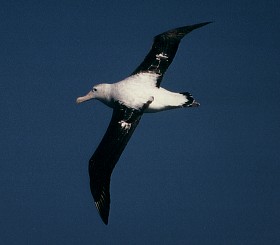nr.441
Wandering Albatross, Diomedea exulans
Southern Oceans
Breeds on: Inaccesable, Gough, Amsterdam, Auckland, Campbell, Antipodes,
South Georgia, Marion, Prince Edward, Crozet, Kerguelen and Macquarie
islands.
Length: 107-135 cm Wingspan: 254-351 cm,
largest wingspan of any bird.

Very large Albatross. In all agegroups has mostly white underwings, with
blackish primaries and a blackish narrow trailing edge. Head white, bill
pinkish. Juvinile birds largely brown except for distinctive white face
mask. Belly and throat sometimes white. As birds mature upperparts gradually
whiten. Estimated breeding pairs at 21,000. Wandering Albatrosses can cover
vast tracks of the southern ocean, flying up to several thousand kilometres
on a single foraging trip. |